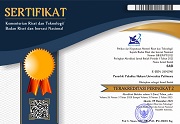Pembukaan Prinsip Kerahasiaan Bank sebagai Perbuatan Melawan Hukum
 )
)
(1) Pascasarjana Ilmu Hukum Universitas Indonesia, Jakarta, Indonesia
 Corresponding Author
Corresponding Author
Abstract
Keywords
DOI
10.47268/sasi.v26i4.238
Published
2020-12-30
How To Cite
@article{SASI238,
author = {Dinda Zatika},
title = {Pembukaan Prinsip Kerahasiaan Bank sebagai Perbuatan Melawan Hukum},
journal = {SASI},
volume = {26},
number = {4},
year = {2020},
keywords = {Banking Secrecy; Violations; Financial Services Authority; Tort of Law},
abstract = {Banking secrecy is known in many countries in the world that has a bank financial institution. Banking secrecy is one of the most important principle. It is because the development and growth of one bank is very dependant on public trust. Confidentiality of information that is born in banking activities, is needed for the benefit of the bank and also the interest of the customer itself. This research discussed about how is the function of the banking financial institution in protecting their customers through the banking secrecy and how is the form of tort of law against the banking secrecy in a judicial proceedings that linked to the case. Method used in this research is juridical normative research. Data are collected by literatures and documents studies, then analyzed using descriptive qualitative analysis. The results of this research indicate that to overcome problems with the banking secrecy, interference from the authorities in the consumer protection sector in the field of financial services is needed, that is Financial Services Authority institution or in Indonesian it is called Otoritas Jasa Keuangan. The institution is expected to be able to protect customers from financial service business that are considered to harm the interests of customers. In the case, the customer sued the bank for violation of banking secrecy on the basis of tort of law that is contrary to the bank’s legal obligations and the law as referred to the article 40 paragraph 1 of the Banking Law.},
issn = {2614-2961}, pages = {500--513} doi = {10.47268/sasi.v26i4.238},
url = {https://fhukum.unpatti.ac.id/jurnal/sasi/article/view/238}
}
Jurnal
[1] Catur PS, Bambang. (2014), "Pengamanan Pemberian Kredit Bank dengan Jaminan Hak guna Bangunan", Jurnal Cita Hukum, 2 (2): 273-288.
https://doi.org/10.15408/jch.v1i2.1468
[2] Faisal, Fitriah. (2018), "Pengaruh Prinsip Kerahasiaan Bank Terhadap Tindak Pidana Pencucian Uang", Al-Amwal: Journal of Islamic Economic Law, 3 (1): 35-60. DOI: https://doi.org/10.24256/alw.v3i1.198
[3] Hanifah, Mardalena. (2010), "Tindakan Hukum Secara Perdata Terhadap Pelanggaran Rahasia Bank". Normative, 1 (12).
[4] Hasima, Rahman. (2020), "Implikasi Hukum Terhadap Akad yang Memuat Klausula Penyelesaian Sengketa Perbankan Syariah Melalui Pengadilan Negeri Pasca Putusan Mahkamah Konstitusi Nomor 93/PUU-X/2012" SASI, 26 (3): 286-296, DOI: https://doi.org/10.47268/sasi.v26i3.247
[5] Labetubun, Muchtar A H. (2012). "Kompetensi Pengadilan Agama Terhadap Penyelesaian Sengketa Perbankan Syariah Berdasarkan Hukum Islam", SASI, 18 (1): 56-62, DOI: https://doi.org/10.47268/sasi.v18i1.337.
[6] Rani, Marnia. (2014), "Perlindungan Otoritas Jasa Keuangan Terhadap Kerahasiaan dan Keamanan Data Pribadi Nasabah Bank", Jurnal Selat, 2 (1): 168-181.
[7] Sarapi, Nancy. (2013), "Usaha Bank Menjaga Rahasia Bank Dalam Rangka Perlindungan Terhadap Nasabah". LEX ET SOCIETATIS, 1 (4): 57-65.
[8] Sitompul, Zulkarnain. (2004), "Menyambut Kehadiran Otoritas Jasa Keuangan (OJK)", Pilars, 7 (2).
[9] Towoliu, Wolly P. (2013), "Fungsi Lembaga Perbankan Dalam Melindungi Nasabah Melalui Aspek Kerahasiaan Bank", Jurnal Hukum Unsrat, 1 (2): 11-24.
Buku
[10] Asikin, Zainal. 2015. Pengantar Hukum Perbankan Indonesia. Jakarta: Raja Grafindo Persada.
[11] Djumhana, Muhammad. 2006. Hukum Perbankan di Indonesia. Bandung: Citra Aditya Bakti.
[12] Gazali, Djoni S. dan Rachmadi Usman. 2010. Hukum Perbankan. Jakarta: Sinar Grafika.
[13] Husein, Yunus. 2010. Rahasia Bank dan Penegakan Hukum. Jakarta: Pustaka Juanda Tigalima.
[14] Soekanto, Soerjono dan Sri Mamudji. 2006. Penelitian Hukum Normatif (Suatu Tujuan Singkat). Jakarta: Rajawali Pers.
[15] Syamsiar, Ratna. 2014. Hukum Perbankan. Bandar Lampung: Justice Publisher.
Tesis dan Lain-Lain
[16] Arie, Siti Sundari. (2011). "Hukum Bidang Perbankan". Badan Pembinaan Hukum Nasional.
[17] Sjahdeni, Sutan Remy. (1993). Kebebasan Berkontrak dan Perlindungan yang Seimbang Bagi Para Pihak Dalam Perjanjian Kredit Bank di Indonesia. Jakarta: Bankir Indonesia.
[18] Sitompul, Zulkarnain. (2006). "Dasar Filosofi Keberadaan Lembaga Penjamin Simpanan". Seminar Nasional Fakultas Hukum Universitas Airlangga Lembaga Penjamin Simpanan Sebagai Wahana Perlindungan Dana Simpanan Nasabah, 1 Juli 2006.
[19] Sjahdeni, Sutan Remy. (2005). "Rahasia Bank: Berbagai Masalah Di Sekitarnya". Bahan Diskusi Mengenai Legal Issues Seputar Pengaturan Rahasia Bank Indonesia.
[20] Sidabutar, Rachel Indrasary. (2006). Ketentuan Hukum Rahasia Bank Sebagai Suatu Bentuk Perikatan Bidang Perbankan. Tesis, Hukum Universitas Airlangga.
| Dublin Core | PKP Metadata Items | Metadata for this Document | |
| 1. | Title | Title of document | Pembukaan Prinsip Kerahasiaan Bank sebagai Perbuatan Melawan Hukum |
| 2. | Creator | Author's name, affiliation, country | Dinda Anna Zatika; Pascasarjana Ilmu Hukum Universitas Indonesia, Jakarta; Indonesia |
| 3. | Subject | Discipline(s) | |
| 3. | Subject | Keyword(s) | Banking Secrecy; Violations; Financial Services Authority; Tort of Law |
| 4. | Description | Abstract | Banking secrecy is known in many countries in the world that has a bank financial institution. Banking secrecy is one of the most important principle. It is because the development and growth of one bank is very dependant on public trust. Confidentiality of information that is born in banking activities, is needed for the benefit of the bank and also the interest of the customer itself. This research discussed about how is the function of the banking financial institution in protecting their customers through the banking secrecy and how is the form of tort of law against the banking secrecy in a judicial proceedings that linked to the case. Method used in this research is juridical normative research. Data are collected by literatures and documents studies, then analyzed using descriptive qualitative analysis. The results of this research indicate that to overcome problems with the banking secrecy, interference from the authorities in the consumer protection sector in the field of financial services is needed, that is Financial Services Authority institution or in Indonesian it is called Otoritas Jasa Keuangan. The institution is expected to be able to protect customers from financial service business that are considered to harm the interests of customers. In the case, the customer sued the bank for violation of banking secrecy on the basis of tort of law that is contrary to the bank’s legal obligations and the law as referred to the article 40 paragraph 1 of the Banking Law. |
| 5. | Publisher | Organizing agency, location | Faculty of Law, Universitas Pattimura |
| 6. | Contributor | Sponsor(s) | |
| 7. | Date | (YYYY-MM-DD) | 2020-12-30 |
| 8. | Type | Status & genre | Peer-reviewed Article |
| 8. | Type | Type | |
| 9. | Format | File format | PDF, HTML |
| 10. | Identifier | Uniform Resource Identifier | https://fhukum.unpatti.ac.id/jurnal/sasi/article/view/238 |
| 10. | Identifier | Digital Object Identifier | 10.47268/sasi.v26i4.238 |
| 11. | Source | Title; vol., no. (year) | SASI; Vol 26, No 4 (2020): Volume 26 Nomor 4, Oktober - Desember 2020 |
| 12. | Language | English=en | en |
| 13. | Relation | Supp. Files | |
| 14. | Coverage | Geo-spatial location, chronological period, research sample (gender, age, etc.) | |
| 15. | Rights | Copyright and permissions | Copyright: Authors who publish their manuscripts in this Journal agree to the following conditions: 1. The copyright in each article belongs to the author, as well as the right to patent. 2. Authors can enter into separate, additional contractual arrangements for the non-exclusive distribution of the journal's published version of the work (e.g., post it to an institutional repository or publish it in a book), with an acknowledgment of its initial publication in this journal. 3. Authors are permitted and encouraged to post their work online (e.g., in institutional repositories or on their website) before and during the submission process, as it can lead to productive exchanges, as well as earlier and greater citation of published work. 4. Authors have the right to self-archiving of the article (Author Self-Archiving Policy)
License: The SASI Journal is disseminated based on the Creative Commons Attribution-NonCommercial 4.0 International license terms. This license allows anyone to copy and redistribute this material in any form or format, compose, modify, and make derivatives of this material for any purpose. You cannot use this material for commercial purposes. You must specify an appropriate name, include a link to the license, and certify that any changes have been made. You can do this in a way that is appropriate but does not imply that the licensor supports you or your use.
|
Copyright (c) 2020 Dinda Anna Zatika

This work is licensed under a Creative Commons Attribution-NonCommercial 4.0 International License.

 : 7724 times
: 7724 times Download : 3366 times
HTML
Download : 3366 times
HTML 















